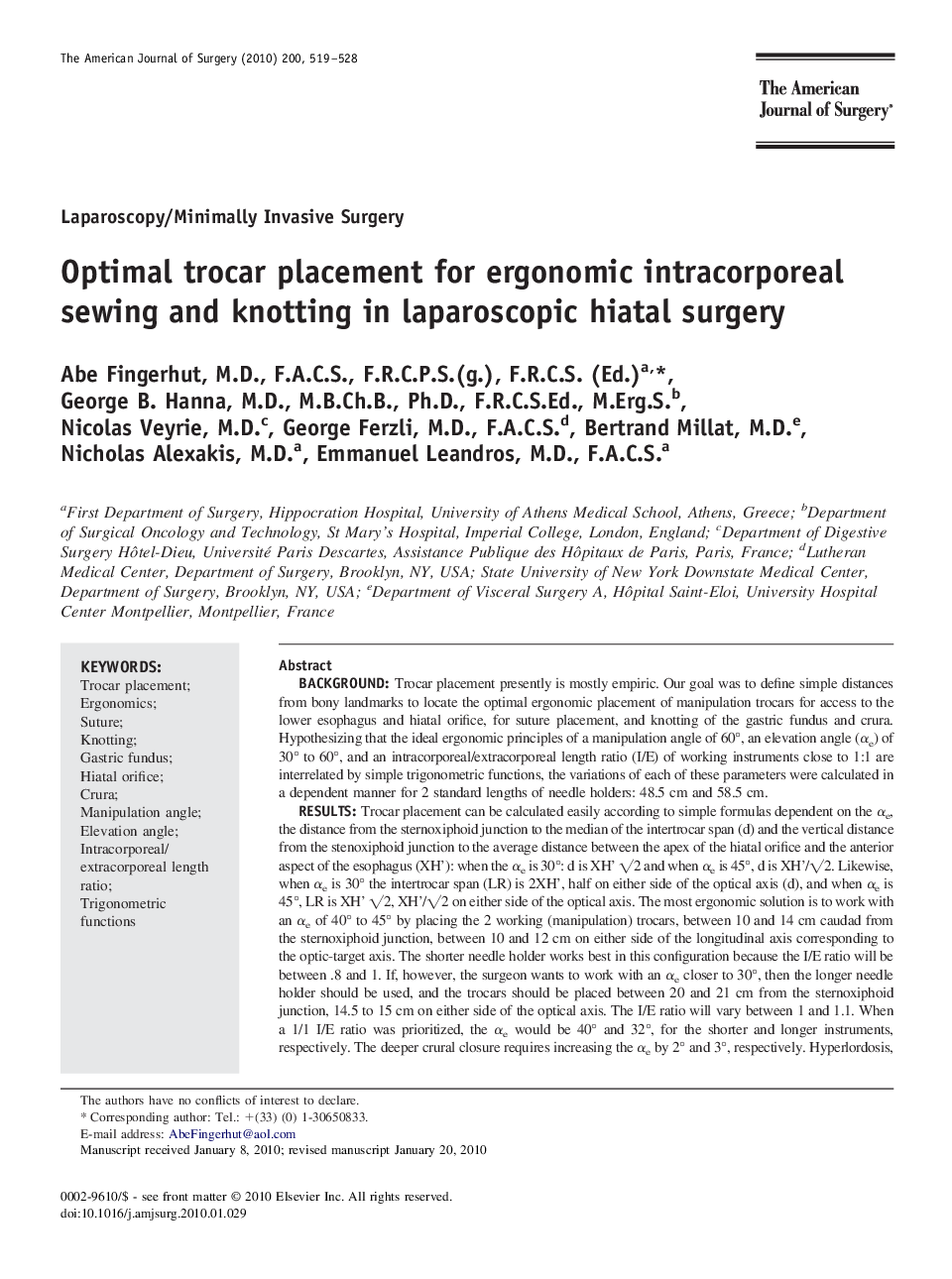| کد مقاله | کد نشریه | سال انتشار | مقاله انگلیسی | نسخه تمام متن |
|---|---|---|---|---|
| 4280213 | 1611550 | 2010 | 10 صفحه PDF | دانلود رایگان |

BackgroundTrocar placement presently is mostly empiric. Our goal was to define simple distances from bony landmarks to locate the optimal ergonomic placement of manipulation trocars for access to the lower esophagus and hiatal orifice, for suture placement, and knotting of the gastric fundus and crura. Hypothesizing that the ideal ergonomic principles of a manipulation angle of 60°, an elevation angle (αe) of 30° to 60°, and an intracorporeal/extracorporeal length ratio (I/E) of working instruments close to 1:1 are interrelated by simple trigonometric functions, the variations of each of these parameters were calculated in a dependent manner for 2 standard lengths of needle holders: 48.5 cm and 58.5 cm.ResultsTrocar placement can be calculated easily according to simple formulas dependent on the αe, the distance from the sternoxiphoid junction to the median of the intertrocar span (d) and the vertical distance from the stenoxiphoid junction to the average distance between the apex of the hiatal orifice and the anterior aspect of the esophagus (XH'): when the αe is 30°: d is XH' √2 and when αe is 45°, d is XH'/√2. Likewise, when αe is 30° the intertrocar span (LR) is 2XH', half on either side of the optical axis (d), and when αe is 45°, LR is XH' √2, XH'/√2 on either side of the optical axis. The most ergonomic solution is to work with an αe of 40° to 45° by placing the 2 working (manipulation) trocars, between 10 and 14 cm caudad from the sternoxiphoid junction, between 10 and 12 cm on either side of the longitudinal axis corresponding to the optic-target axis. The shorter needle holder works best in this configuration because the I/E ratio will be between .8 and 1. If, however, the surgeon wants to work with an αe closer to 30°, then the longer needle holder should be used, and the trocars should be placed between 20 and 21 cm from the sternoxiphoid junction, 14.5 to 15 cm on either side of the optical axis. The I/E ratio will vary between 1 and 1.1. When a 1/1 I/E ratio was prioritized, the αe would be 40° and 32°, for the shorter and longer instruments, respectively. The deeper crural closure requires increasing the αe by 2° and 3°, respectively. Hyperlordosis, as obtained by placing a cushion under the patient's back, shortens the distances, allowing placement of the trocars closer to the sternoxiphoid junction.ConclusionsBased on ergonomic principles (manipulation angle, 60°; αe, 40°–45°; and an I/E ratio of working instruments, close to 1:1), simple trigonometric considerations allow easy calculation of the ideal placement of trocars corresponding to working instruments in hiatal surgery necessary for ergonomic dissection, suturing, and intracorporeal knotting. Ideal trocar placement is dependent only on the vertical depth of the target organ.
Journal: The American Journal of Surgery - Volume 200, Issue 4, October 2010, Pages 519–528